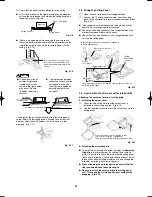
37
Caution Before Connecting Tubes Tightly
(1) Apply a sealing cap or water-proof tape to prevent dust or
water from entering the tubes before they are used.
(2) Be sure to apply refrigerant lubricant to the matching
surfaces of the flare and union before connecting them
together. This is effective for reducing gas leaks. (Fig. 7-4)
Apply refrigerant lubricant.
Fig. 7-4
(3) For proper connection, align the union tube and flare tube
straight with each other, then screw on the flare nut lightly
at first to obtain a smooth match. (Fig. 7-5)
Flare nut
Union
Fig. 7-5
●
Adjust the shape of the liquid tube using a tube bender at the
installation site and connect it to the liquid tubing side valve
using a flare.
Cautions During Brazing
●
Replace air inside the tube with nitrogen gas to prevent
copper oxide film from forming during the brazing
process. (Oxygen, carbon dioxide and Freon are not
acceptable.)
●
Do not allow the tubing to get too hot during brazing.
The nitrogen gas inside the tubing may overheat,
causing refrigerant system valves to become damaged.
Therefore allow the tubing to cool when brazing.
●
Use a reducing valve for the nitrogen cylinder.
●
Do not use agents intended to prevent the formation
of oxide film. These agents adversely affect the
refrigerant and refrigerant oil, and may cause damage or
malfunctions.
7-2. Connecting Tubing Between Indoor and Outdoor
Units
(1) Tightly connect the indoor-side refrigerant tubing extended
from the wall with the outdoor-side tubing.
(2) To fasten the flare nuts, apply specified torque.
●
When removing the flare nuts from the tubing connections,
or when tightening them after connecting the tubing, be sure
to use 2 adjustable wrenches or spanners. (Fig. 7-6)
If the flare nuts are over-tightened, the flare may be damaged,
which could result in refrigerant leakage and cause injury or
asphyxiation to room occupants.
Outdoor unit
Torque wrench
Spanner
Indoor unit
Fig. 7-6
●
When removing or tightening the gas tube flare nut, use 2
adjustable wrenches together: one at the gas tube flare nut,
and the other at part A. (Fig. 7-7)
A
Fig. 7-7
●
For the flare nuts at tubing connections, be sure to use the
flare nuts that were supplied with the unit, or else flare nuts
for R410A (type 2). The refrigerant tubing that is used must
be of the correct wall thickness as shown in the table below.
Tube diameter
Tightening torque
(approximate)
Tube thickness
ø6.35 (1/4")
14 – 18 N · m
(140 – 180 kgf · cm)
0.8 mm
ø9.52 (3/8")
34 – 42 N · m
(340 – 420 kgf · cm)
0.8 mm
ø12.7 (1/2")
49 – 61 N · m
(490 – 610 kgf · cm)
0.8 mm
ø15.88 (5/8")
68 – 82 N · m
(680 – 820 kgf · cm)
1.0 mm
Because the pressure is approximately 1.6 times higher than
conventional refrigerant pressure, the use of ordinary flare
nuts (type 1) or thin-walled tubes may result in tube rupture,
injury, or asphyxiation caused by refrigerant leakage.
●
In order to prevent damage to the flare caused by over-
tightening of the flare nuts, use the table above as a guide
when tightening.
●
When tightening the flare nut on the liquid tube, use an
adjustable wrench with a nominal handle length of 200 mm.
●
Do not use a spanner to tighten the valve stem caps. Doing
so may damage the valves.
●
Depending on the installation conditions, applying excessive
torque may cause the nuts to crack.
Precautions for Packed Valve Operation
●
If the packed valve is left for a long time with the valve stem
cap removed, refrigerant will leak from the valve. Therefore,
do not leave the valve stem cap removed. (Fig.7-8)
●
Use a torque wrench to securely tighten the valve stem cap.
Packed valve
Charging port
Valve stem
Main valve
Valve stem cap
Fig. 7-8
●
Valve stem cap tightening torque:
Charging port
8 – 10 N • m (80 – 100 kgf • cm)
ø9.52 (Liquid side)
19 – 21 N • m (190 – 210 kgf • cm)
ø15.88 (Gas side)
28 – 32 N • m (280 – 320 kgf • cm)
Pac-i̲2nd̲eng3.indd 37
Pac-i̲2nd̲eng3.indd 37
2009/07/13 13:38:32
2009/07/13 13:38:32
Содержание OU-PSINV-25HR
Страница 75: ...75 ...
















































